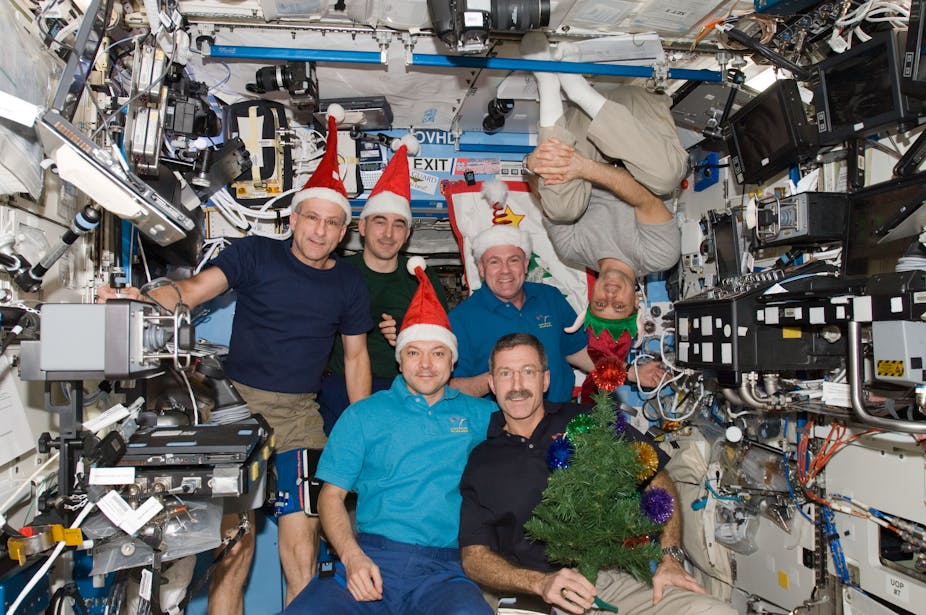Christmas - whether you’re religious or not - is a time when people gather their families together to reinforce the bonds that make us human.
In the era of modern telecommunications, distance no longer separates people the way it once did. Whether you’re on another continent, another planet, or floating out in space, satellites enable us to talk to and see each other, to feel connected.
And speaking of Christmas and space, it turns out the two have a bit of a history.

An Apollo Christmas
Apollo 8 was a Christmas mission, the only one of all the Apollo missions. On December 21, 1968, astronauts Frank Borman, Jim Lovell and Bill Anders blasted off from Cape Kennedy on a Saturn V rocket.
Their Christmas gift to the world was an extraordinary photograph that became one of the icons of the 20th century.
As they orbited the moon a few days after launch, an unscheduled change in orientation suddenly brought the earth into their view. The astronauts scrambled to get their cameras working, and Bill Anders took the famous shot of the Earth rising over the lunar horizon.

For the first time we saw our whole world from the outside. The fragility and beauty of the blue-and-white globe floating in the sea of darkness ignited an awareness of how interconnected the people of Earth are.
The nascent environmental movement drew inspiration from this vision and people really began to appreciate that we are only a small part of a rather large universe.
The Apollo program provided more concrete presents as well. The crew of Apollo 17, the last men on the moon, made a December 19 splashdown loaded with a 100kg-Santa’s-sack-worth of lunar rocks – our biggest collection so far. Many of these moon rocks were given as goodwill gestures to other nations.
They’re now the most valuable rocks in the world; each lump may be worth millions, as we have no idea when we’ll have the opportunity to get some more. Unbelievably, quite a few of these precious rocks have gone missing!
Home and away
The Apollo missions demonstrated that humans could survive in space; what they couldn’t tell us was whether it was possible to actually live for an extended amount of time in space. This was the purpose of Skylab - the first US spacecraft to be designed as a living space, a home away from home.
Skylab was launched in 1973 and hosted three crews (Skylab 1 was unmanned) during its short working life. While in the space station, the astronauts enjoyed showers, a special dining area, and a sadly punishing toilet routine - everything that left their bodies had to be kept for future analysis.
The crew of the Skylab 4 mission celebrated Christmas in 1973 with a crafty piece of improvisation. Astronauts Gerald Carr, William Pogue and Edward Gibson made this charming Christmas tree out of empty food cans.

Wasting valuable mission time to make the tree may have been a passive act of resistance to having every minute of their waking days overplanned. Later in the three-month mission, the exhausted crew allegedly “mutinied” and chucked the first sickie in space.
Christmas merchandise
On Earth and on the moon, space was quickly incorporated into Christmas traditions.
In 1947, Woomera in South Australia became the location of one of the earliest rocket launch sites in the world. The card shown below, with a Christmas greeting inside, depicts a V2-like rocket being launched over the desert.
Germany developed the V2 in WWII and it became the basis of Cold War space programs in the US, UK, France and Russia. Two ended up in Australia and are now at the Australian War Memorial in Canberra. The card seems to send a rather mixed message about war and peace …

Soviet Russia also got into the Christmas card action though not officially – the celebration of Christmas was not encouraged during the Soviet era.
That said, the card below, which depicts St Nicholas and three USSR spacecraft, leaves no doubt that the spirit of Christmas nonetheless endured. (Bonus points if you can identify the spacecraft!)

Not to be outdone on either the space or Christmas card race, NASA responded in style. In the shot below, the Apollo 14 crew of Alan Shepard, Ed Mitchell and Stuart Roosa, receive a Christmas card from James Loy, Chief, Protocol Branch for the KSC Public Affairs Office.
Note the crew peeping out from behind the Christmas tree on the card.

Every NASA mission generates merchandise and memorabilia - patches, t-shirts, mugs, etc. But did you know you could give your own Christmas tree a NASA makeover?
The image below, and the one above of Santa and an Apollo capsule, show souvenir Christmas tree ornaments from the Kennedy Space Centre.
2012 Christmas in space
This Christmas will be a quiet one in space. That said, on December 19 a crew of three flight engineers did launch from Kazakhstan to complete expedition 34 on the International Space Station.

NASA astronaut Tom Marshburn, Russian cosmonaut Roman Romanenko, and Canadian astronaut Chris Hadfield will get to celebrate Christmas twice - once on December 25, and again for the Russian Orthodox feast on January 7.
Like many modern families, the Mars Rover family – Curiosity, Opportunity and Spirit – will spend the Christmas period far from each other, albeit on the red planet. (For Santa to include them in his rounds, he may need to battle the Martians - or so they thought in this classic 1964 film).
Similarly, the twin Voyager spacecraft are moving ever further apart from each other on their missions to interstellar space.
But it’s not all bad. The same technologies which created the Mars Rover family and the Voyager twins led to our modern telecommunications network.
Human and robot alike are linked in a web of electromagnetic waves that keep us communicating and connected. In space, no-one need feel alone, particularly at Christmas.

